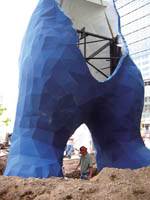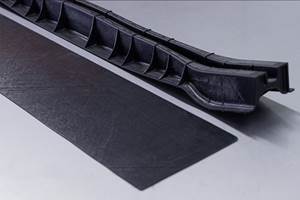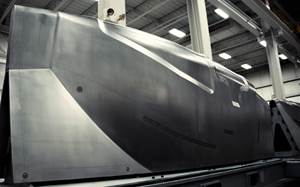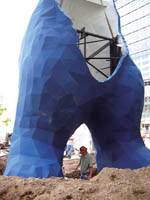The big blue bear: Redux
It’s been 12 years since I wrote “Composite Sculpture Bears a Second Look” about the big blue bear sculpture in downtown Denver, CO, US. The project opened my eyes to digital design, and gave me the opportunity to meet the sculptor, Lawrence Argent. Argent passed away last week.
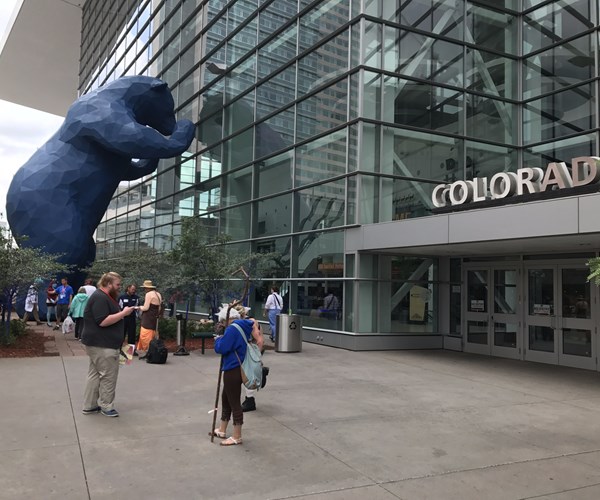
The blue bear sculpture in Denver, CO, US designed by Lawrence Argent. Photo source: Westword
It’s been 12 years since I wrote Composite Sculpture Bears a Second Look. If you don’t remember it, the article described the installation of a large sculpture, made primarily of fiberglass, at the Colorado Convention Center in downtown Denver, CO, US. The giant bright blue bear was installed with its back to the street, peering through the building’s glass curtain wall at the visitors inside. The 40-ft tall sculpture, actually entitled “I See What you Mean,” was fabricated in segments by Kreysler & Associates Inc. (American Canyon, CA, US), a world-renowned composites manufacturer noted for architectural and sculptural projects (another recent CW story involving Kreysler’s fabrication of the façade for the San Francisco Museum of Modern Art). The blue bear has become a beloved and iconic Denver landmark, although it has endured several art bombings including green paint, a deposit of fake blue poop and a yarn ball and chain.
The fun part for me was the chance to drive downtown and talk to company founder Bill Kreysler while the bear’s segments were installed and bolted together. A truly interesting aspect was that the project represented one of the first uses of digital design, which Kreysler was able to import into his CNC equipment to directly machine the female molds, eliminating the intermediate step of plugs/models. That direct-to-mold approach, and the use of expanded polystyrene (EPS) molds, many of which were re-machined and reworked for different sculpture segments, reduced the project costs according to Kreysler.
Which brings me to the real reason for revisiting the blue bear. The sculpture was designed by Lawrence Argent, arguably one of Colorado’s most famous artists and the creator of many public artworks. The idea for the bear came to him, he told me in 2005, from a small plastic children's toy, which he scanned with a three-dimensional laser-scanning device to convert the 3D shape into a CAD computer file. He then had the shape printed by an early 3D printer from Stratasys Inc. (Eden Prairie, Minn.) to create a small scale-model plastic maquette or model. As luck would have it, the plastic polymer used in the 3D printer was bright blue in color, and Argent liked it so much he decided it would be the sculpture’s final color.
Argent died unexpectedly this past week, October 4th, in Denver. As reported in the journal Westword, Argent was born in 1957 in Essex, England, but was raised in Australia, where he attended art school at the Royal Melbourne Institute of Technology. He came to the US and attended the Rinehart School of Sculpture, Maryland Institute, College of Art in Baltimore, where he earned an MFA in 1986. He taught for a few years in Texas and California before accepting a teaching job at the School of Art and Art History at the University of Denver in 1993. In 2017, he was named a professor emeritus at DU.
Argent was an early adopter of digital technologies and embraced composites for many of his sculptures, including those installed around the Denver region. He certainly helped to open my eyes to how composites could be employed in ways beyond airplanes, pipes and bridges.
Related Content
Optimized approach to predict delamination failure in CFRTP structures
ARRK Engineering and Mitsui Chemicals improved delamination prediction accuracy to help optimize absorbed energy/failure load for an overmolded TAFNEX CF/PP UD tape bumper beam.
Read MoreActive core molding: A new way to make composite parts
Koridion expandable material is combined with induction-heated molds to make high-quality, complex-shaped parts in minutes with 40% less material and 90% less energy, unlocking new possibilities in design and production.
Read MoreASCEND program update: Designing next-gen, high-rate auto and aerospace composites
GKN Aerospace, McLaren Automotive and U.K.-based partners share goals and progress aiming at high-rate, Industry 4.0-enabled, sustainable materials and processes.
Read MoreNine factors to consider when designing composites cure tooling
Gary Bond discusses the common pitfalls and compromises when designing good cure tooling and their holistic significance for a robust composite production process.
Read MoreRead Next
Composite Sculpture Bears A Second Look
"Paperless" design and plug-free moldmaking enable cost-effective scale-up of miniature model to massive monument.
Read MorePlant tour: Daher Shap’in TechCenter and composites production plant, Saint-Aignan-de-Grandlieu, France
Co-located R&D and production advance OOA thermosets, thermoplastics, welding, recycling and digital technologies for faster processing and certification of lighter, more sustainable composites.
Read MoreDeveloping bonded composite repair for ships, offshore units
Bureau Veritas and industry partners issue guidelines and pave the way for certification via StrengthBond Offshore project.
Read More

